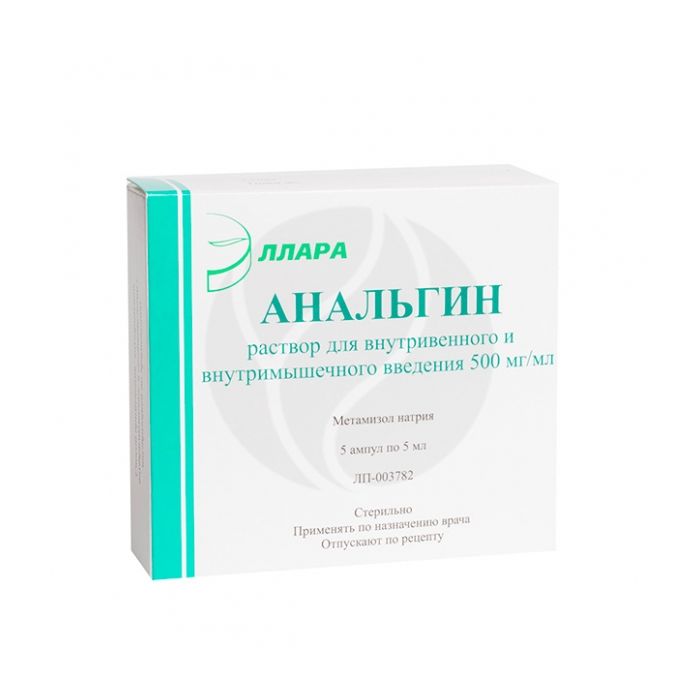Analgin injection solution 50%, 5ml No. 5
Expiration Date: 05/2027
Russian Pharmacy name:
Анальгин раствор для инъекций 50%, 5мл №5
Pain syndrome of weak and moderate intensity (headache and toothache, neuralgia, pain in sciatica, osteochondrosis, arthritis, menalgia),
smooth muscle spasms (renal colic, biliary colic, intestinal colic),
feverish conditions in infectious and inflammatory diseases (as part of combination therapy).
V / v, v / m. For adults and adolescents over 15 years of age, a single dose is 2Ц5 ml (i / v or i / m), the daily dose is up to 10 ml. Intravenous administration of a single dose exceeding 2 ml (1 g) is possible only after a thorough statement of the indications. For children and infants, the daily dose is set taking into account the body weight (infants 5-8 kg - 0.1-0.2 ml i / m; children 9-15 kg - 0.2-0.5 ml i / v or i / m; children 16-23 kg - 0.3-0.8 ml i / v or i / m; children 24-30 kg - 0.4-1 ml i / v or i / m; 31-45 kg - 0.5-1.5 ml i / v or i / m; 46-53 kg - 0.8-1.8 ml i / v or i / m. IV administration of the drug should be carried out slowly (1 ml within 1 min), in the supine position and under the control of blood pressure, heart rate and respiration.The injection solution should have body temperature.
Active substance: metamizole sodium
Hypersensitivity to pyrazolones (including metamizolisopropylaminophenazone, propiphenazone and phenazone-containing drugs, phenylbutazone).
Acute hepatic porphyria
congenital deficiency of glucose-6-phosphate dehydrogenase.
pharmachologic effect
Analgesic antipyretic. Derived from pyrazolone. It has analgesic, antipyretic and anti-inflammatory effects, the mechanism of which is associated with inhibition of prostaglandin synthesis.
Side effect
Allergic reactions: skin rash, Quincke's edema; rarely - anaphylactic shock.
From the hematopoietic system: rarely, with prolonged use - leukopenia, agranulocytosis.
Local reactions: with intramuscular injection - infiltrates at the injection site.
Contraindications for use
Severe renal and / or liver dysfunction, glucose-6-phosphate dehydrogenase deficiency, blood diseases, hypersensitivity to pyrazolone derivatives.
Application during pregnancy and lactation
Use with caution during pregnancy, especially in the first trimester and in the last 6 weeks.
Application for violations of liver function
Contraindicated in severe liver dysfunction.
Application for impaired renal function
Contraindicated in severe renal impairment.
Application in children
Use with caution in children in the first 3 months of life.
Single doses for children aged 2-3 years are 50-100 mg; 4-5 years old - 100-200 mg; 6-7 years old - 200 mg; 8-14 years old - 250-300 mg; frequency of admission - 2-3 times / day.
special instructions
With prolonged use, it is necessary to control the peripheral blood picture.
Metamizole sodium is used in combination with pitofenone and fenpiverinium bromide as an analgesic with an antispasmodic effect.
Use with caution in children in the first 3 months of life.
Drug interactions
With simultaneous use with analgesics, antipyretics, with NSAIDs, mutual intensification of toxic effects is possible.
With simultaneous use with inducers of microsomal liver enzymes, it is possible to reduce the effectiveness of metamizole sodium.
With simultaneous use, the activity of indirect anticoagulants, oral hypoglycemic drugs, GCS, indomethacin increases due to their displacement from the connection with blood proteins under the influence of sodium metamizole.
With simultaneous use with phenothiazine derivatives, severe hyperthermia is possible; with sedatives, anxiolytics - the analgesic effect of metamizole sodium is enhanced; with tricyclic antidepressants, oral contraceptives, allopurinol - the metabolism of metamizole sodium is disrupted and its toxicity increases; with caffeine - the effect of sodium metamizole is enhanced; with cyclosporine - the concentration of cyclosporine in the blood plasma decreases.
When metamizole sodium is used in combination with pitofenone hydrochloride (it has a direct myotropic effect on the smooth muscles of internal organs and causes its relaxation) and with fenpiverinium bromide (m-anticholinergic blocker), their pharmacological action is mutually reinforced, which is accompanied by a decrease in pain syndrome, relaxation of smooth muscles and a decrease in elevated body temperature.

